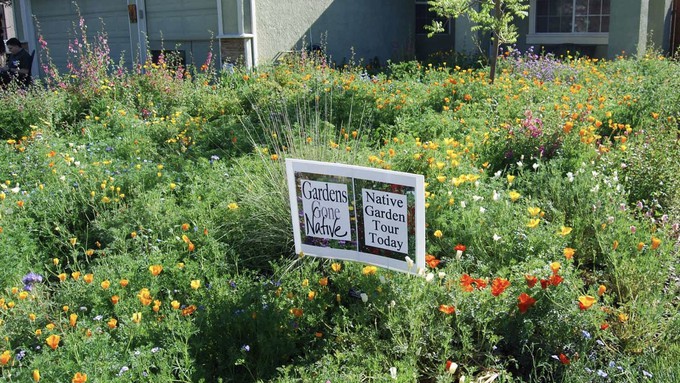
Sacramento Valley CNPS event spotlights wildlife-friendly landscapes

This colorful garden was part of a previous Gardens Gone Native tour. This year, 30 gardens from Woodland to Rocklin are on the tour Saturday. Photo courtesy SacValley CNPS
This garden tour covers a lot of ground – and inspiration. This Saturday, April 27, visitors can see 30 local wildlife-friendly landscapes that spotlight California native plants.
Hosted by the Sacramento Valley Chapter of the California Native Plant Society, the “Gardens Gone Native” tour stretches throughout the greater Sacramento area. The tour is free, but registration is required to get the addresses, tour brochure and map.
Each of the gardens is at least 50% native plants. Some are well-established; others are relatively new. Every garden does something for local wildlife as well as the people who care for these plants. Many of these native-centric gardens are distinctly Sacramentan.
Since it's a self-guided tour, see as many or as few gardens as you like.
“The Gardens Gone Native tour is a free garden tour featuring 30 California native plant home and school gardens in the Sacramento region,” says SacValley CNPS. “Gardens are comprised predominantly of California native plants in the urban landscape.
“These gardens feature a variety of ways in which native plants can flourish in the home garden,” add the organizers. “Some are professionally designed while others are more functional and are a mix use of natives, food production, and living spaces. You will find delightful and sustainable gardens that harness water, create habitats, and add a sense of place.”
Don’t just drive by; get out and see these gardens up close – and ask questions. This is an opportunity to really learn about natives from gardeners with personal experience. How did they grow their gardens? What’s their secret to native success? What wouldn't they plant again?
“Attendees will have the opportunity to ask garden hosts about their choices and challenges," say the organizers.
Tour hours are 9:30 a.m. to 4 p.m. Saturday. See virtual tours of past “Gardens Gone Native” as well as register at https://www.sacvalleycnps.org/gardens-gone-native-tour/.
Comments
0 comments have been posted.Sacramento Digs Gardening to your inbox.
Food in My Back Yard Series
May 6: Maintain soil moisture with mulch for garden success
April 29: What's (already) wrong with my tomato plants?
April 22: Should you stock up on fertilizer? (Yes!)
April 15: Grow culinary herbs in containers
April 8: When to plant summer vegetables
April 1: Don't be fooled by these garden myths
March 25: Fertilizer tips: How to 'feed' your vegetables for healthy growth
March 18: Time to give vegetable seedlings some more space
March 11: Ways to win the fight against weeds
March 4: Potatoes from the garden
Feb. 25: Plant a fruit tree now -- for later
Feb. 18: How to squeeze more food into less space
Feb. 11: When to plant? Consider staggering your transplants
Feb. 4: Starting in seed starting
Sites We Like
Garden Checklist for week of May 11
Make the most of the lower temperatures early in the week. We’ll be back in the 80s by Thursday.
* Plant, plant, plant! It’s prime planting season in the Sacramento area. Time to set out those tomato transplants along with peppers and eggplants. Pinch off any flowers on new transplants to make them concentrate on establishing roots instead of setting premature fruit.
* Direct-seed melons, cucumbers, summer squash, corn, radishes, pumpkins and annual herbs such as basil.
* Harvest cabbage, lettuce, peas and green onions.
* In the flower garden, direct-seed sunflowers, cosmos, salvia, zinnias, marigolds, celosia and asters. (You also can transplant seedlings for many of the same flowers.)
* Plant dahlia tubers.
* Transplant petunias, marigolds and perennial flowers such as astilbe, columbine, coneflowers, coreopsis, dahlias, rudbeckia and verbena.
* Keep an eye out for slugs, snails, earwigs and aphids that want to dine on tender new growth.
* Feed summer bloomers with a balanced fertilizer.
* For continued bloom, cut off spent flowers on roses as well as other flowering plants.
* Add mulch to the garden to maintain moisture. Mulch also cuts down on weeds. But don’t let it mound around the stems or trunks of trees or shrubs. Leave about a 6-inch-to-1-foot circle to avoid crown rot or other problems.
* Remember to weed! Pull those nasties before they set seed.
* Water early in the day and keep seedlings evenly moist.